Painfully delicious: discovering natural history knowledge through angling
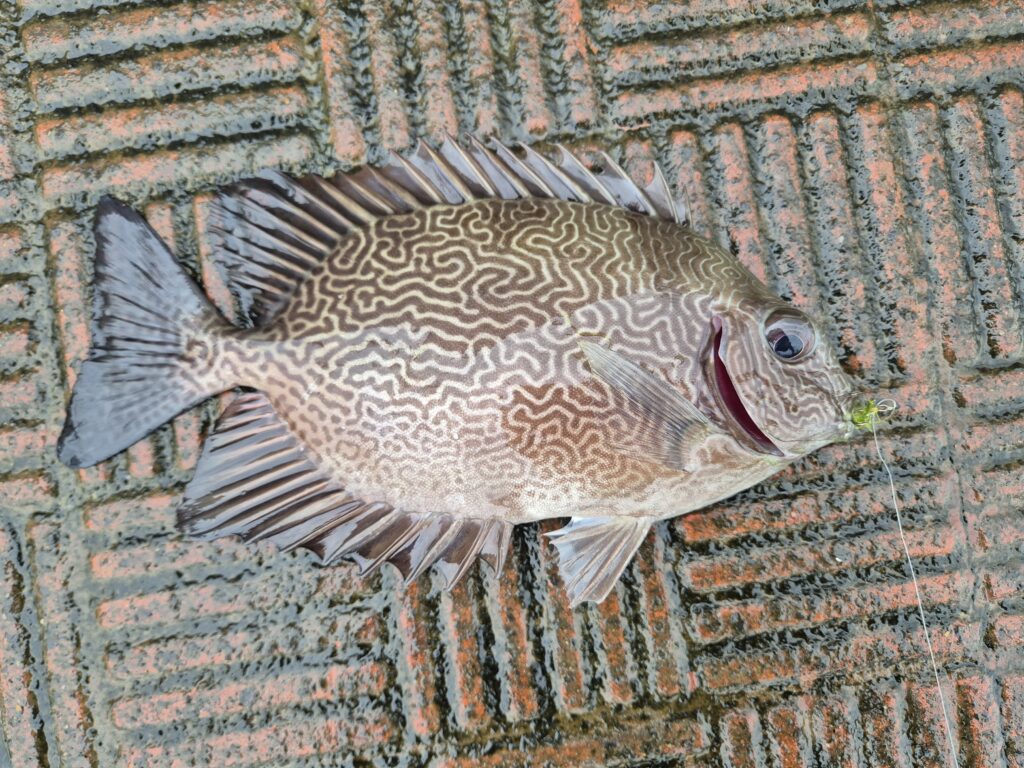
My red and white float vanished beneath the laterite-orange waters of the Mandovi River, not with the usual bobbing of small fish but with a steady pull—I had hooked something! Instead of jerking the line, with a firm grip I guided the rod towards the steps, carefully hauling the fish out in a long single drag. The rabbitfish thrashed on the steps at Reis Magos, where my son Noam and I, along with three other anglers, had been fishing. Its venomous spines fanned out as it fluttered. I stopped it with a gentle step on its head, gripping it by the gills to safely remove the hook without being pricked.
I held up the fish, admiring its beautiful maze pattern of golden-brown lines. Aptly called the maze rabbitfish (Siganus vermiculatus), locally escrivão, the Portuguese name for clerk/writer attributed to the same maze script.
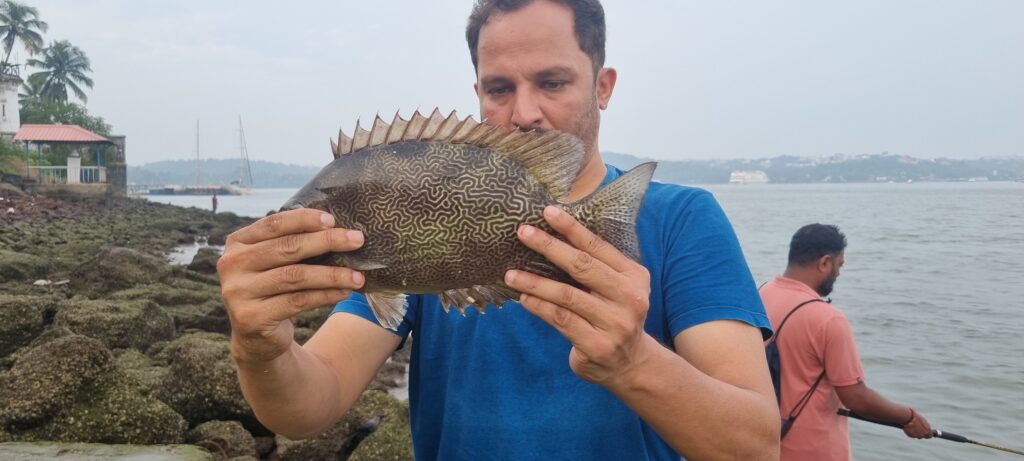
The fish jerked and fluttered, making me loosen my grip. It fell on the steps and began bouncing its way down the stairs once again. I made the mistake of sticking out my hand to prevent it from falling back into the river—which I successfully did, but one of its erect spines jabbed my little finger, a sting that I felt instantly. Similar to a hypodermic needle, each spine of the rabbitfish has a groove that runs along its edge which delivers a toxic venom. My finger was bleeding, andthe pain got worse with every passing minute. Its Konkani name baanoshi is attributed to its toxic spines—where baan refers to an arrow.
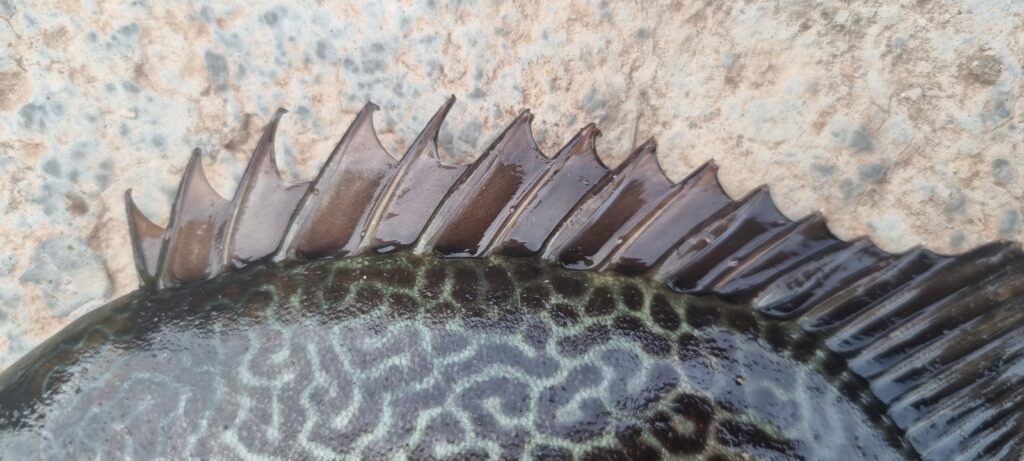
An angler standing nearby said that the pain can get so intense that some even wet their pants, giving the rabbitfish its other name: muthri in Konkani, pisser in English.
Rabbitfish venom is similar in its makeup to that of the highly venomous stonefish, which is often considered the most dangerous fish in the sea, sometimes causing lethal stings. While rabbitfish venom isn’t as severe, that sting will be difficult to forget.
A fish of the monsoon
The best time to fish for rabbitfish in Goa is soon after the onset of the monsoon. In 2023, they arrived unusually late, but when they did it poured incessantly—so much so that the state received half its average annual rainfall in less than a month (by the end of July). The monsoons in Goa have traditionally always been a time for anglers because the seas are just too rough for commercial fisheries to be venturing out to sea, besides being a great “time pass”.
Most coastal states in India have a two-month monsoon fishing ban, which was put in place to prevent the industrial (mechanised) fishing sector—including trawlers and purse seiners—from overfishing resources during this period. This ban excludes the traditional fishers who use passive and less destructive techniques. Goa has six major rivers/backwaters and a large network of waterways which come alive with both fish and anglers during the monsoons.
In this season, high levels of nutrients washed by the rains are carried down by the rivers, all the way from the hills to the ocean. While there are a large number of marine algae species in Goa, particularly luxuriant is the growth of a long, stringy, bright green algae which can be seen growing on and coating the intertidal rocky shores of Goa. This seaweed Ulva intestinalis, locally called shelo in Konkani, is an ephemeral resource, abundant only for a short period during the monsoon. A diversity of herbivorous fish including rabbitfish, surgeonfish and rudderfish arrive in mixed shoals to graze on the tender blooms of marine algae.
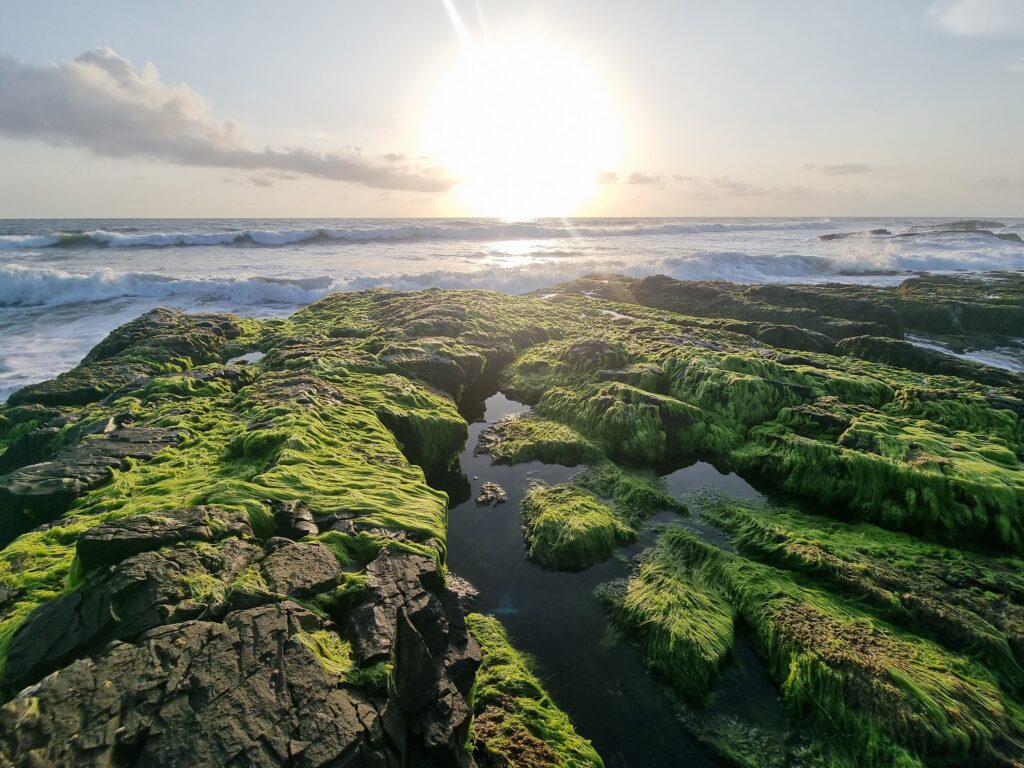
Ingenious anglers have figured out the value of this fast-dwindling seaweed resource. Fattened on the seaweed, these fish venture up the estuary where they deposit thousands of eggs among the tangle of mangrove roots upriver, which provide the young refuge and food. The trick used by the anglers is to follow the baanoshi as they migrate up the river. In the muddy backwaters, the seasonal shelo which thrives on the rocky shoreline becomes a scarce commodity and using it upriver invites bites in rapid succession.
In search of Shelo
Noam and I had spent the previous evening stripping shelo off exposed rocks that had not yet been discovered by other anglers. We managed to collect two fistfuls, which we stored in a small plastic box with a little water collected from the vicinity to prevent it from drying up. As divine fate would have it, the skies opened up the following afternoon, which unsurprisingly brought out a large number of anglers from their homes. Our rig setup was relatively simple—a bamboo rod with line float, a small lead shot weight and a small treble hook attached to each line. A treble hook looks like an anchor with three evenly spaced barbed prongs extending from a single shaft. The hair-like seaweed bait is wrapped along all three prongs to disguise the hook and increase the chances of catching a rabbitfish during angling.
However, for reasons I am unsure of, using shelo as bait only works in the early half of the monsoon. Anglers who know their rabbitfish switch to using small pieces of fish or shrimp as bait, because they won’t take to shelo when the monsoon begins to wane. I don’t know the ecological basis, but it could just be because the algal blooms at the onset of the monsoons are tender and possibly more nutritious and digestible, as compared to the more mature patches. Another reason is that the algal resource tends to dwindle as the season progresses.
Successful fish
There are approximately 30 species of rabbitfish that are distributed in the Indo-Pacific and the Eastern Mediterranean. They are important to fisheries in most of their range, particularly artisanal fisheries, and constitute an important source of food to many coastal communities.
Being herbivores and the fact that seaweed is ubiquitous, rabbitfish occur in a range of environments from brackish estuaries like the Mandovi to marine environments, including clear coral reefs, and are even found in very degraded marine habitats. There are also other aspects of their biology such as their high fecundities (they lay a large number of eggs) that allow them to withstand even heavy fishing pressures. Rabbitfish are also known to be highly adaptable, moulding their behaviour and biology to adapt to a new environment, making them “phenotypically plastic”.
In fact, these species have been so successful that they’ve colonised regions where they were once non native. When the Suez Canal opened in 1869, connecting the Mediterranean and the Red Sea, it drastically shortened travel time and reduced shipping costs between Europe and Asia. However, few considered the long-term ecological consequences. Over the years, hundreds of species migrated from the Red Sea to the Mediterranean—a process known as the Lessepsian migration, named after Ferdinand de Lesseps, who oversaw the canal’s construction. Many of these species have outcompeted the native Mediterranean fish, becoming dominant in local ecosystems. Today, they form a significant part of regional fisheries and have even become integral to local cuisine.
Among the Lessepsian migrants are two species of rabbitfish—the marbled rabbitfish (Siganus rivulatus) and the dusky rabbitfish (Siganus luridus), both native to the Red Sea. These species entered the Mediterranean via the Suez Canal, first recorded in 1924 and 1956, respectively. Since then, they’ve established large populations in the Eastern Mediterranean, outcompeting native herbivorous fish by the early 2000s. In Lebanon’s coastal lagoons, for example, they make up 80 percent of the herbivorous fish population. Marbled rabbitfish have even been recorded as far west as Malta, and in parts of Turkey and Crete, they’ve overgrazed marine algae, creating barren areas. They now constitute a significant portion of fish catches in the Eastern Mediterranean.
Climate change is also driving the movement of the tropical rabbitfish to temperate parts of the world which they have now happily made their homes.

Eating the rabbitfish
We took our rabbitfish home. Noam, like he typically does, insisted he wanted it cooked the same evening. I steamed it as is done in many parts of Southeast Asia—in a colander with finely chopped ginger and garlic in soy sauce. He decided to use chopsticks, deftly peeling back the skin to reveal the steaming white flesh. I always found the skin of rabbitfish bitter. It was cooked to perfection, the flesh tender yet firm.
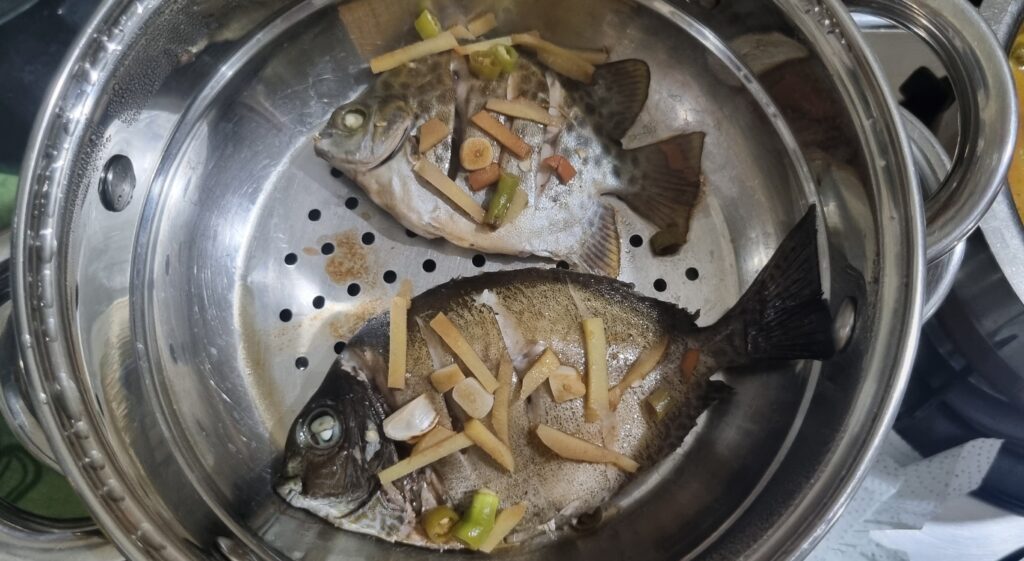
While I have eaten rabbitfish for some years now, they are among a few species whose consumption during a particular season can cause what is called hallucinogenic fish inebriation or ichthyoallyeinotoxism. I haven’t yet heard of cases such as these from Goa yet. We slept well that night.
Further Reading
Mebs, D. 2017. Biology and distribution of venomous marine animals. In: Handbook of Clinical Toxicology of Animal Venoms and Poisons. (eds. White, J. and J. Meier). Pp 85-88. Boca Raton: CRC Press.
Metar, S. Y., V. H. Nirmale, U. Gurjar, M. M. Shirdhankar, V. R. Sadawarte, N. D. Chogale, A. N. Sawant et al. 2023. Feeding habits and reproductive biology of the rabbitfish, Siganus vermiculatus, along the central west coast of India.Journal of the Marine Biological Association of India: 65(1): 91–96.
Sala, E., Z. Kizilkaya, D. Yildirim and E. Ballesteros.2011.Alien marine fishes deplete algal biomass in the eastern Mediterranean. PLOS ONE 6(2): e17356.